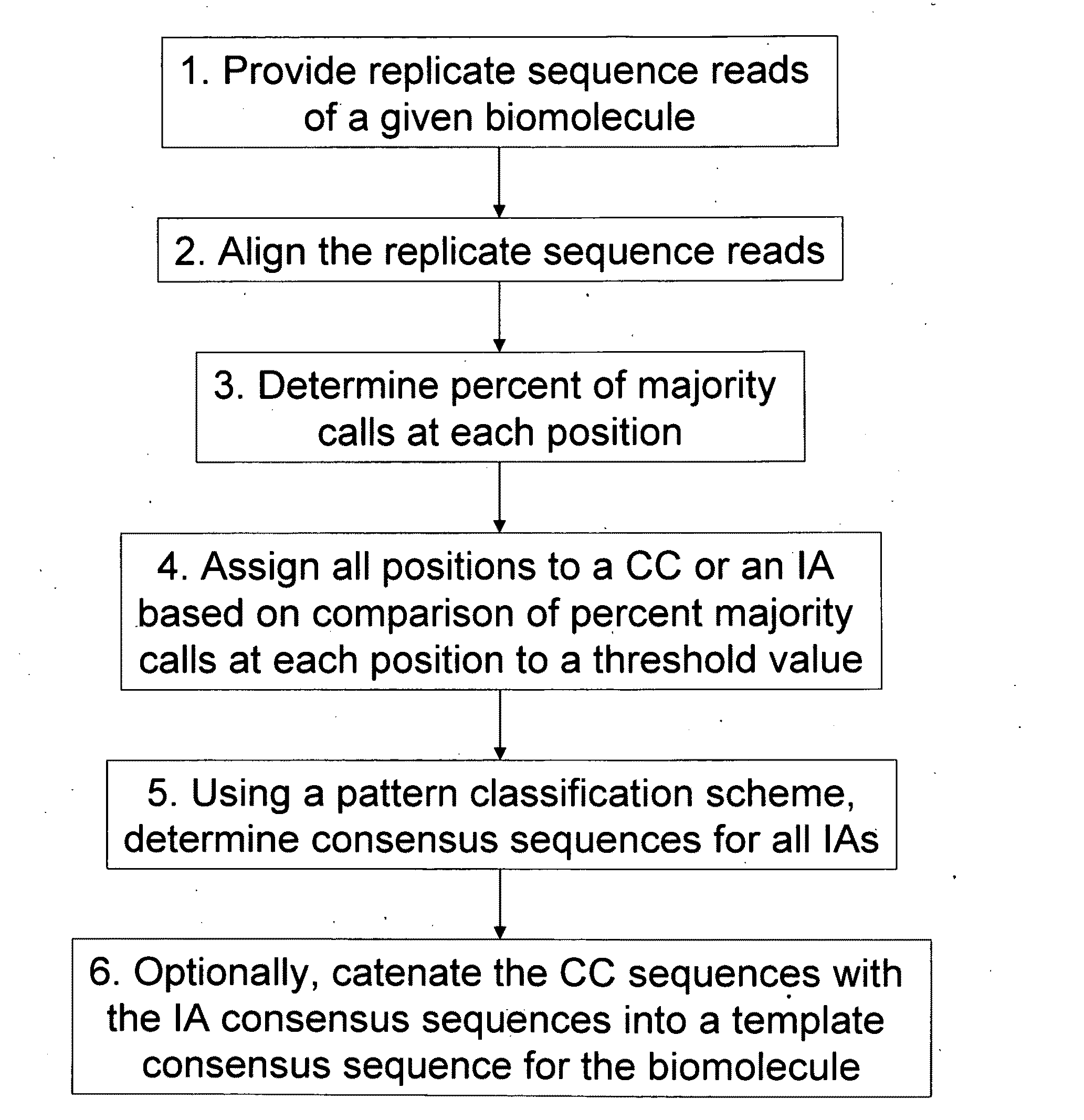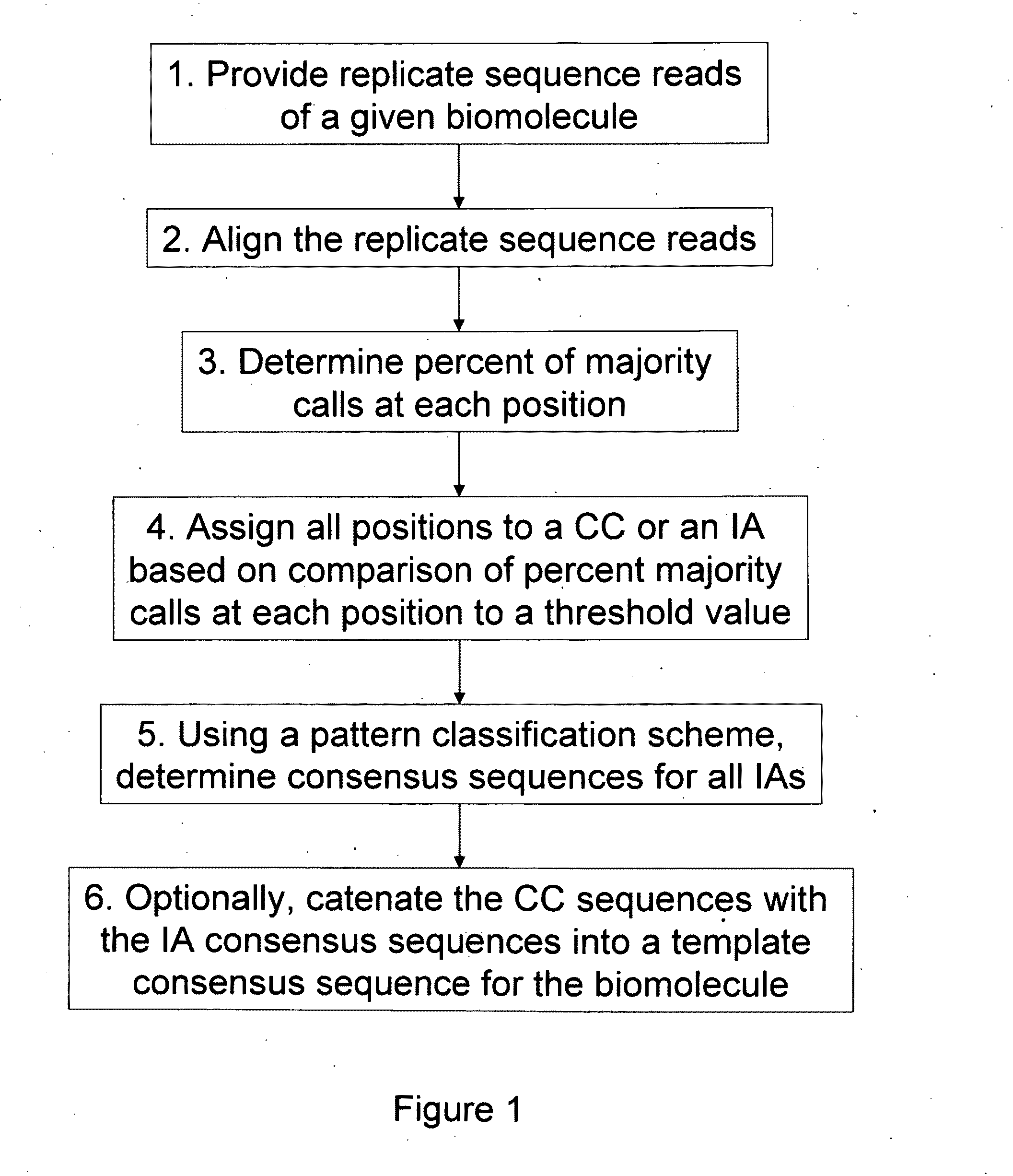Algorithms for sequence determination
- Summary
- Abstract
- Description
- Claims
- Application Information
AI Technical Summary
Benefits of technology
Problems solved by technology
Method used
Image
Examples
example i
VII. Example I
Modeling Errors in a Sequencing-by-Synthesis Experiment with Hidden Markov Models
[0104]Assessing the performance of a single-molecule, real-time sequencing system relies on comparisons between the sequence of a known template and the sequence emitted by an experiment. A hidden Markov model (HMM) was constructed to analyze the accuracy of sequencing-by-synthesis experiments and provide accurate estimates of system parameters, and this model is described in detail below.
Mapping Between Sequencing Procedures and Hidden Markov Models
[0105]The hidden Markov model used employs a very simple underlying state structure that models the progression of the polymerase along its template. At each time step the molecule can move forward to the next template location or stay at the current template location (FIG. 7). The states of the HMM (except the final state) are in one to one correspondence with template locations.
[0106]At each transition the model either emitted a symbol that r...
example ii
VIII. Example II
[0154]A consensus basecall was determined in an MSA using a pattern classification model that accounted for the local context of the sequence alignment and comprised two steps: (1) estimation of the context-dependent alignment model parameter using whole genome multiple sequence alignment; and (2) use of the estimated model parameters to both determine consensus basecalls and provide a value indicating the discrimination power for the position so basecalled.
[0155]For a position in the E. coli K12 genome (position 1904826 of the K12 NCBI reference sequence), it was observed that (nj,A, nj,c, nj,G, nj,T, nj;)=(2, 5, 10, 8, 7) for the “T” base in the “CGTGG” 5-mer. Using the following context-dependent base frequencies from the whole genome multiple sequence alignment of a 47-fold coverage of sequencing reads:
fCGAGG=(A:0.688953,C:0.0921108,G:0.103457,T:0.0351911,-:0.0802874)
fCGCGG=(A:0.0331184,C:0.785788,G:0.0947676,T:0.0317243,-:0.0546016)
fCGGGG=(A:0.0384701,C:0.087394...
example iii
IX. Example III
[0157]Consensus basecalls were determined in an MSA using a pattern classification model that applied an all path probabilistic alignment to assign confidence values to basecalls. For each of the four possible bases (“A”, “C”, “G”, and “T”) at each template position, the confidence values from each read at a given location were summed. The summed confidence values were defined as the consensus confidence values, and were correlated with empirical Phred-style empirical quality values (EQV) as shown in FIG. 12. To demonstrate the usefulness of such consensus confidence values, the number of bases in the test data set that were still retained after application of the quality filter was determined. This number was compared with the empirical quality value derived using fold-coverage as the binning method for deriving the EQV. FIG. 13 shows how many basecalls remained when the consensus bases below a given QV threshold were filtered out. When the QV derived by the confiden...
PUM
 Login to View More
Login to View More Abstract
Description
Claims
Application Information
 Login to View More
Login to View More - R&D
- Intellectual Property
- Life Sciences
- Materials
- Tech Scout
- Unparalleled Data Quality
- Higher Quality Content
- 60% Fewer Hallucinations
Browse by: Latest US Patents, China's latest patents, Technical Efficacy Thesaurus, Application Domain, Technology Topic, Popular Technical Reports.
© 2025 PatSnap. All rights reserved.Legal|Privacy policy|Modern Slavery Act Transparency Statement|Sitemap|About US| Contact US: help@patsnap.com



